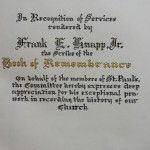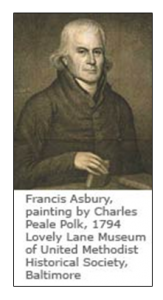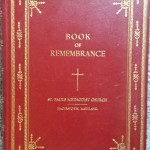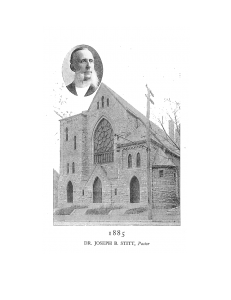On Sunday, November 22, 2015 we celebrated the 130th anniversary of the dedication of our beautiful sanctuary. Here we share information regarding the history of St. Paul’s/John Wesley UMC.
 Our church has a magnificent hand-written history book entitled Book of Remembrance. This book is constructed in beautiful calligraphy. The second page notes that this book was “rendered by Frank E. Knapp, Jr., the scribe of the Book of Remembrance.”This book was completed and dedicated in July, 1958. It contains a wonderful record of the early years of our church.
Our church has a magnificent hand-written history book entitled Book of Remembrance. This book is constructed in beautiful calligraphy. The second page notes that this book was “rendered by Frank E. Knapp, Jr., the scribe of the Book of Remembrance.”This book was completed and dedicated in July, 1958. It contains a wonderful record of the early years of our church.
 The first entry lists the year 1776 and reports that on “July 17 Bishop Francis Asbury preached in Hagerstown, and this was the beginning of Methodism here.” What an amazingly simple yet powerful way to open our history! Within two weeks of the signing of the Declaration of Independence, the first bishop of the Methodist Church came to Hagerstown to proclaim the gospel message.
The first entry lists the year 1776 and reports that on “July 17 Bishop Francis Asbury preached in Hagerstown, and this was the beginning of Methodism here.” What an amazingly simple yet powerful way to open our history! Within two weeks of the signing of the Declaration of Independence, the first bishop of the Methodist Church came to Hagerstown to proclaim the gospel message.
It was 18 years later that the Methodists in Hagerstown became “officially” recognized in the history books of Methodism. The entry under 1794 records the following: “Hagerstown became part of the Carlisle Circuit. On the beginning of Circuits, it is recorded, that doubtless so important a place as the largest frontier town west of the mountains, found place as an appointment.”
So this is our beginning. A group of Christians in “the largest frontier town west of the mountains” united together to form a new denomination called Methodists under the leadership of Francis Asbury.
————————————————————————————————————-
Another excerpt from the Book of Remembrance:
“1812 – Hagerstown was attached to the Chambersburg Circuit.
August 27 – Bishop Asbury records his visit to Hagerstown, preaching to about 100 hearers in the new chapel. . . The chapel was erected on the present site of St. Paul’s Evangelical United Brethren Church (now Otterbein United Methodist Church).
Records indicate that it was built jointly by United Brethren and Methodists on the condition of free and uninterrupted use ‘of the building by the . . . Brethren every alternative Sabbath and at other times when not occupied by the Methodists’ . . .
——————————————————————————————————
In the early years of Methodism in Hagerstown, the Methodists and the United Brethren shared a church facility which was located at the current site of Otterbein United Methodist Church on the corner of Franklin and Locust Streets.
The following entry in The Book of Remembrance gives us a glimpse into the excitement and spiritual growth which was taking place in those early years:
1825
The Methodist Society had so increased as to need
a separate and larger Church,
and proceeded to build on North Jonathan Street
on the lot adjoining the Thomas Building.
The rectangular brick edifice of one story remained
as erected until 1866, when it was remodeled,
and provided a lecture room at street level
and an auditorium above.
Our ancestors had bought land and built their first church building.
——————————————————————————————————————–
 Our story last ended with our church (then apparently referred to as The Methodist Episcopal Church of the Hagerstown Station) being located on “North Jonathan Street.” Regarding this first church building, one of the old sources notes that it was “(p)aid for in two years.” After approximately 60 years at that location it became obvious that a newer and larger facility was needed.
Our story last ended with our church (then apparently referred to as The Methodist Episcopal Church of the Hagerstown Station) being located on “North Jonathan Street.” Regarding this first church building, one of the old sources notes that it was “(p)aid for in two years.” After approximately 60 years at that location it became obvious that a newer and larger facility was needed.
—————————————————————————————————————
According to the Book of Remembrance, “During the pastorate of Dr. Dashielle (1880-82) preparations were made for the erection of a new Church”. The next entry is dated October 23, 1883 – “The present lot” (now identified as 129 N. Potomac Street) “was purchased and on December 15, ground was broken. Plans for the Building were adopted by the Trustees and approved by the congregation.”
According to the Book of Remembrance , in an entry dated August 7, 1884 “The Corner Stone was laid, at which time the name ‘St. Paul’s’ was given to the rapidly rising structure.”
And so, in 1884 an old house begins to be replaced by a new house. A new house which will, for the next 84 years, carry the name of St. Paul’s Methodist Church. (Our church was called Methodist Episcopal until the year 1939 when we merged back together with the Methodist Protestant Church and the Methodist Episcopal Church, South. But that’s another story!) In 1884 we move into our current church home, the home we now know as John Wesley United Methodist Church!
—————————————————————————————————————–
Let us take some time to explain what was happening at this time in our church history. Methodism came to America by English missionaries and preachers sent by John Wesley beginning in the 1760’s . As the Methodist movement grew, the early leaders decided to call for an Annual Conference meeting to develop working principles and understandings among the early Methodists. This meeting became known as The Christmas Conference beginning on December 24, 1784. This first Annual Conference was held in Baltimore, MD at the Lovely Lane Chapel. Because of our roots in the Anglican Church, the name given to the new church was The Methodist Episcopal Church.
The church continued to grow and spread throughout the new nation called the United States of America. As time went by, groups of Methodists became concerned about what they perceived as increasing power on the part of their ministers and their bishops. These new young Americans were feeling excluded from power and decision making and after much discussion and prayer, one faction decided to leave the Methodist Episcopal Church. In 1828 a split occurred and the result was the birth of the Methodist Protestant Church.
As America began to grow and prosper the issue of slavery emerged as a major conflict between all Americans, including members of the Methodist Episcopal Church. Not surprisingly, those who lived in the north favored abolition of slavery and those in the south resisted the abolition movement. This issue continued to be raised at the yearly Annual Conferences and by 1844, Methodist Episcopal church members living in the south decided that they would leave the northern branch of the church. In 1844, the original church of our ancestors was divided into 3 major branches – the Methodist Episcopal Church, the Methodist Protestant Church and the Methodist Episcopal, South. We maintained the name of St. Paul’s Methodist Episcopal Church.
As the years went by, all three branches of the church began to open discussions about the power of becoming reunified in the work of Jesus Christ (“we, though many, are one” Rom. 12:5). So, in 1939, the three branches came back together under the name of the Methodist Church. Specifically, we went from being St, Paul’s Methodist Episcopal Church to St. Paul’s Methodist Church.
The next merger came in 1968 when the Methodists and the Evangelical United Brethren churches joined together forming the new United Methodist Church. We then changed our name to John Wesley United Methodist Church.
——————————————————————————————————————–
Until the year 1968 our church was named St. Paul’s Methodist Church. Last month we traced the heritage of our church along the “Methodist path” from our beginnings at the “Christmas Conference” in Baltimore in 1784 to the present day. But our church DNA includes Brethren genes as well. What follows is a shortened version of that “other story”.
In May of 1767 a “Great Meeting” was held in a barn in Lancaster, PA. Two groups of Christians were present, Mennonites and German Reformed followers. As the two groups shared their faith, two of their prominent leaders, Martin Boehm and Philip Otterbein, embraced one another proclaiming “We are Brethren”. These followers later formulated a combined church in 1800 which came to be named Church of the United Brethren in Christ. This church was similar in belief and structure to the early Methodist Church. Relations with the Methodist Church were so close that Philip Otterbein even attended the first “Christmas Conference” of the Methodists in 1784 in Baltimore, MD.
Just like the history of the Methodist Church, the United Brethren Church experienced a series of splits and mergers. For example, in Pennsylvania a large group of German speaking Christians had formed their own denomination under the leadership of Jacob Albright and using many of the early Wesleyan Methodist beliefs and structures. In 1800 this new group took the name of The Evangelical Church/Association. As the members of the Evangelical Church began to adopt the English language they soon realized their kinship with the members of the United Brethren Church. In 1946 The Evangelical Church decided to merge themselves with the United Brethren Church. The new church name? The Evangelical United Brethren Church.
Hagerstown was blessed with a church from each tradition – the Evangelical United Brethren and the Methodist tradition. Both Hagerstown churches had chosen to be named St. Paul’s. Then, in 1968 when the Evangelical United Brethren and Methodist churches decided to merge together nationally, each church wisely choose to take on the name of the early leader of their particular branch. Thus, we continue to be “brothers and sisters” together known as Otterbein and John Wesley United Methodist Churches! We ARE family!
——————————————————————————————————————
The following is an excerpt from “The Annals of Methodism in Hagerstown” written by A.M. Courtney (1887), as found in History and Records of St. Paul’s Methodist Episcopal Church, 1825–1910, Hagerstown, Maryland by Mary Burgner Greenawalt.
 “On Oct. 23, 1883, a lot was purchased on North Potomac Street and on Dec. 15 following, the ground was broke. Plans for the edifice were, after much consideration, adopted by the Trustees, subject to the approval of a Congregational meeting held May 11, 1884, which was then given. At the same time subscriptions, previously secured by private solicitation were announced, and additional offerings were made sufficient to justify the Trustees in proceeding with the work. The design was made by Chas. Carson, Esq., Architect of Baltimore, and the Builder was B.F. Bennett of Baltimore. The contract was signed June 1884, and the building rapidly rose to completion. The Corner-Stone was laid Aug. 7, 1884, at which time the name “St. Paul’s” was given to the rapidly rising edifice.
“On Oct. 23, 1883, a lot was purchased on North Potomac Street and on Dec. 15 following, the ground was broke. Plans for the edifice were, after much consideration, adopted by the Trustees, subject to the approval of a Congregational meeting held May 11, 1884, which was then given. At the same time subscriptions, previously secured by private solicitation were announced, and additional offerings were made sufficient to justify the Trustees in proceeding with the work. The design was made by Chas. Carson, Esq., Architect of Baltimore, and the Builder was B.F. Bennett of Baltimore. The contract was signed June 1884, and the building rapidly rose to completion. The Corner-Stone was laid Aug. 7, 1884, at which time the name “St. Paul’s” was given to the rapidly rising edifice.
“The Corner-Stone contained a Copper Box in which were placed the following articles: Holy Bible; Discipline of the M.E. Church; Copies of “N.Y. Christian Advocate”; the “Baltimore Methodist”; the Hagerstown “Herald and Torch”; “Mail”; “News”; and “Globe”; a list of the officials of Hagerstown City Corporation and Circuit Court; a Programme of the services; Names of the building Committee and Contractor; Officials of the Church; Officers and Teachers of the Sunday School; Retired members of the Baltimore Conference residing in Hagerstown; Officers and Teachers of the West End Sunday School; Several coins and the Key (over 100 years old) of the house which stood on the site of the Church.”
—————————————————————————————————————-
The following is an excerpt from “History of St. Paul’s” written by Mary B. Greenawalt, as found in History and Records of St. Paul’s Methodist Episcopal Church, 1825–1910, Hagerstown, Maryland by Mary Burgner Greenawalt.
November 22, 1885 St. Paul’s Methodist Episcopal Congregation [now John Wesley UMC] dedicated the new sanctuary on North Potomac Street. The building was completed under Dr. J. B. Stitt. There were 400 members and the building cost $50,000.00.
As Hagerstown grew, Methodism kept pace. The western part of the town became well populated and St. Paul’s responded to the need that was felt. Washington Square [United] Methodist Church is the outgrowth of this need. Some years later the southern section of Hagerstown claimed the help of St. Paul’s and the Howard Street Methodist Church came into being. This is now Emmanuel [United] Methodist Church of Hagerstown.
——————————————————————————————————————–
Looking back at our early roots it becomes obvious that John Wesley UMC has had a long history of awareness of the connectional nature of our denomination. We are all a part of the denomination called The United Methodist Church. We are, as St. Paul (the Apostle) says in I Corinthians 12 and Romans 12 , one body with many parts.
John Wesley UMC has always sought to provide an active witness to Jesus Christ as we have worked together with brothers and sisters in the faith community to assist in giving birth to new churches, to provide the personal presence and financial support needed to support helping ministries in this community and around the world, and to provide a family fellowship where all might grow in the faith.
We give thanks for the witness and work of our ancestors here at John Wesley. We pray for the wisdom and the strength to keep this witness going as we engage the challenges that face us as disciples of Jesus Christ in this time and this place.
——————————————————————————————————————
As our church moved into the 20th Century we had been in our “new” (our current) building for 15 years. The church was growing, Hagerstown was growing, and life was good. Then came the unthinkable – two World Wars followed by what was called a “Police Action” in Korea. The members of John Wesley rallied together to be a “family” through these dark times to provide support to those here on the home front and those serving overseas. And through the general efforts of the Methodist Church we reached out in rebuilding and reconciliation efforts for those who had suffered from the direct ravages of the three conflicts.
For all American churches attendance grew and church life was dynamic and vital. Various social factors were at work to account for this surge in church attendance. During the 1950s a new war began to take place. It was called the “Cold War” – the social/political conflict involving drastically differing ideologies between the Soviet Union and the U.S. One of the terrible side-effects of this was the “Red Scare”. In the U.S., neighbors began to suspect one another of being Soviet spies, enemies of the U.S. One of the ways to prove that you were not an atheistic communist was to join a church or a temple. Will Herberg, a leading sociologist observing these trends in the 50’s wrote “not to identify oneself and be identified as . . . a Protestant, a Catholic, or a Jew is somehow not to be an American.” (from Herberg, Protestant, Catholic, Jew)
Another factor to account for large church attendance was the existence of Blue Laws – prohibitions on Sunday activities. Many stores, movie theatres, skating rinks, etc. were closed on Sundays. Thus, church life became one of the key places where social activities could take place.
But as the 1960s, ‘70s and ‘80s came upon us new social/political changes occurred which presented profound changes to all churches – including John Wesley UMC. Blue Laws were removed enabling stores and recreational establishments to open on Sundays. With the end of the Cold War and the collapse of the Soviet Union by the late 1980s many people did not feel pressured to “prove” their identity and loyalty to the U.S. by joining a church or a temple. Other avenues of socialization and recreation became available outside of church life on Sundays. The effect on all religious organizations has been powerful.
——————————————————————————————————–
In preparing for our 130th Anniversary Celebration (that is, 130 years in the current church facility) we came across information which clarified how our name was changed from St. Paul’s to John Wesley. As noted above, with the merger of the Evangelical United Brethren Church and the former Methodist Church back in 1960, two of the largest downtown Hagerstown churches carried the name of St. Paul’s (St. Paul’s Methodist and St Paul’s Evangelical United Brethren). The two churches agreed that each would relinquish the name of St. Paul’s and come up with a new name.
Our church, that is, the current John Wesley UMC, developed an initial list of name possibilities. The list was finally narrowed down to three possibilities The top three name choices were (along with the rationale for each name):
- The United Methodist Church of the Redeemer. “This name was selected because Christ is the Head of the Church. . . The ministry of St. Paul’s . . . is attempting to be one of reconciliation and an instrument working for the redemption . . . of society.”
- Oak Spring United Methodist Church. Located close to the current church property “was a large spring known as Oak Spring, whose waters, famous for their ‘sweetness and purity’, flowed from the roots of an ancient oak as far back as the time of the Indians. The spring (is) now covered over. . . . The church remains the source of refreshment of mind each time its members partake of its living waters.”
- John Wesley United Methodist Church. This name was presented for consideration due to the fact that John Wesley was the founder of the “Methodist” movement in England which later spread to the American colonies.
One May 18, 1969 ballots were cast by 397 church members (5 ballots were “discredited”). The results:
Oak Spring United Methodist Church – 94
United Methodist Church of the Redeemer – 109
John Wesley United Methodist Church – 189
——————————————————————————————————————

